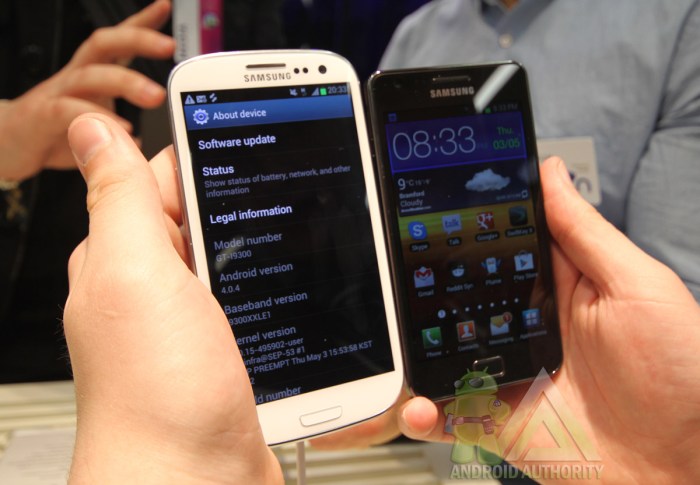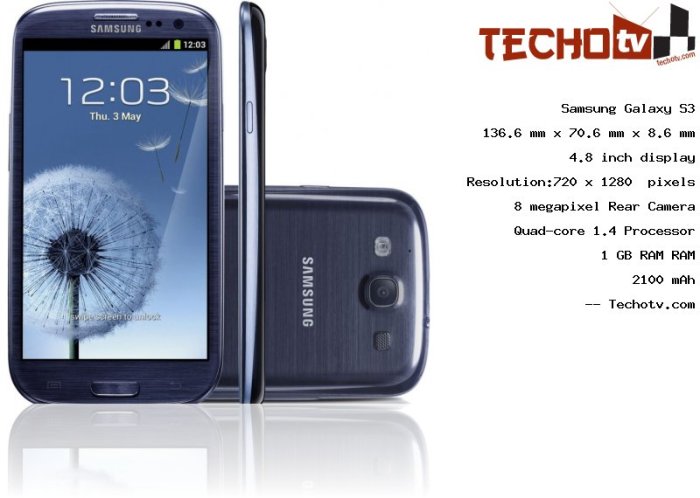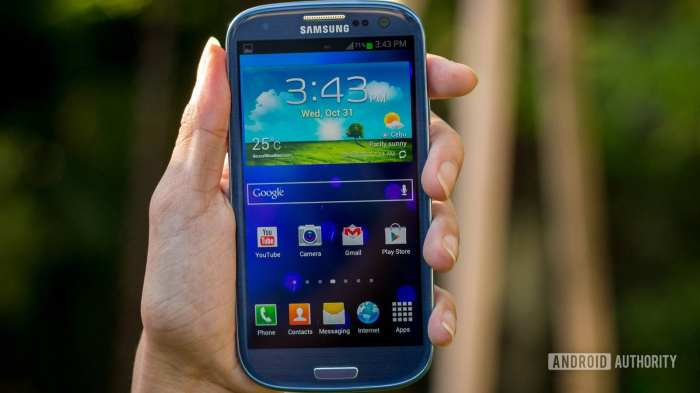Samsung S3 Mobile Specification Details
Samsung Galaxy S3: A Retrospective: Samsung S3 Mobile Specification
Samsung s3 mobile specification – The Samsung Galaxy S3, launched in 2012, holds a significant place in smartphone history. It represented a pivotal moment for Samsung, solidifying its position as a leading mobile manufacturer and significantly impacting the overall smartphone market. This article delves into the device’s specifications, features, and lasting legacy.
Samsung Galaxy S3 Overview

Source: androidauthority.com
The Galaxy S3 was positioned as a premium smartphone targeting a broad audience, appealing to both tech enthusiasts and casual users. Its sleek design and user-friendly interface contributed to its widespread appeal. Released globally in May 2012, it enjoyed a remarkably successful lifecycle, maintaining relevance for several years thanks to timely software updates and its robust hardware.
The S3 featured a design characterized by its smooth, curved back and a large, vibrant display. The overall aesthetic was modern and sophisticated for its time, deviating from the more angular designs prevalent in competing devices. Its lightweight feel and comfortable ergonomics contributed to a positive user experience.
| Feature | Samsung Galaxy S3 | Apple iPhone 4S | HTC One X |
|---|---|---|---|
| Screen Size | 4.8 inches | 3.5 inches | 4.7 inches |
| Processor | 1.4 GHz Exynos 4 Quad or 1.5 GHz Qualcomm Snapdragon S4 | 1 GHz Apple A5 | 1.5 GHz Nvidia Tegra 3 |
| RAM | 1 GB | 512 MB or 1 GB | 1 GB |
| Rear Camera | 8 MP | 8 MP | 8 MP |
Hardware Specifications
The Samsung Galaxy S3 boasted a powerful processor for its time. The Exynos 4 Quad (used in some regions) featured a quad-core ARM Cortex-A9 architecture, while other regions received a dual-core Qualcomm Snapdragon S4. These processors, manufactured using a 32nm process, delivered respectable performance for everyday tasks and gaming.
The device offered 1 GB of RAM and various internal storage options (16GB, 32GB, 64GB). The Super AMOLED capacitive touchscreen boasted a 4.8-inch display with a resolution of 720 x 1280 pixels, resulting in a pixel density of approximately 306 ppi. This screen technology offered vibrant colors and deep blacks, a hallmark of Samsung’s displays at the time.
- Battery Capacity: 2100 mAh
- Battery Type: Lithium-ion
- Expected Usage Time: Varied depending on usage, but generally provided a full day of moderate use.
Software and Features

Source: techotv.com
The Samsung Galaxy S3 initially launched with Android 4.0.3 (Ice Cream Sandwich). Key software features included Samsung’s TouchWiz UI, which offered a customized experience with various widgets and pre-installed applications. These apps ranged from productivity tools to entertainment options, offering users a comprehensive suite of functionalities out-of-the-box. The user interface, while heavily customized, was generally considered intuitive and user-friendly, although some criticized its departure from stock Android.
The Samsung S3, while a notable phone of its time, had certain limitations in its specifications compared to later models. It’s interesting to contrast its features with those of subsequent releases, such as the information available on the samsung galaxy 5s specification , to understand Samsung’s advancements in mobile technology. Returning to the S3, its relatively modest processing power and screen resolution highlight the rapid pace of innovation in the smartphone market.
Compared to modern smartphones, the S3’s software capabilities are significantly limited. The processing power and memory constraints result in slower performance and reduced multitasking capabilities. The operating system is no longer supported with security updates, making it vulnerable to modern threats.
Camera Capabilities
The Samsung Galaxy S3 featured an 8-megapixel rear camera with autofocus and LED flash. It could record 1080p video, a notable feature for its time. Image stabilization was relatively basic, resulting in some blurriness in low-light conditions or when capturing moving subjects. While image quality was acceptable for everyday use, it paled in comparison to the capabilities of modern smartphone cameras.
Low-light performance, in particular, was a notable limitation.
| Feature | Specification | Description | Comparison to Modern Smartphones |
|---|---|---|---|
| Rear Camera | 8 MP | Autofocus, LED flash, 1080p video recording | Significantly lower resolution and features compared to modern smartphones with 48MP+ sensors, advanced image processing, and superior low-light performance. |
| Front Camera | 1.9 MP | Basic video calling capabilities | Resolution is extremely low by today’s standards; modern smartphones offer significantly higher resolution front cameras. |
Connectivity and Network, Samsung s3 mobile specification

Source: androidauthority.com
The Samsung Galaxy S3 supported various network technologies, including 3G and 4G LTE (depending on the region and model). Connectivity options included Wi-Fi, Bluetooth, and NFC. While 4G LTE provided a significant speed boost compared to 3G, it still falls short of the speeds offered by modern 5G networks. The available Wi-Fi standards were also less advanced than those found in contemporary devices.
- GSM/HSPA/LTE (depending on the region and model)
- Wi-Fi 802.11 a/b/g/n
- Bluetooth 4.0
- NFC
Legacy and Impact
The Samsung Galaxy S3 was a commercial success, selling tens of millions of units worldwide. Its popularity cemented Samsung’s position as a major player in the smartphone market, challenging Apple’s dominance. User reviews generally praised its design, performance, and large screen. However, some criticized its TouchWiz interface and its relatively short software update lifecycle. The device played a significant role in popularizing larger-screen smartphones, influencing the design and features of subsequent Samsung Galaxy S series phones.
Compared to later Galaxy S models, the S3’s design appears dated, with its plastic construction and less refined aesthetics. The hardware specifications, particularly the processor and RAM, are significantly less powerful. However, the S3’s success laid the groundwork for the future innovations and advancements seen in the Samsung Galaxy S series.
User Queries
Is the Samsung Galaxy S3 still receiving security updates?
No, the Samsung Galaxy S3 is no longer supported by Samsung and will not receive any further security updates.
Can I still use apps on the Samsung Galaxy S3?
App availability depends on the Android version and app developer support. Many older apps might not function correctly or be available for download.
What is the battery life like on a used Samsung Galaxy S3?
Battery life on a used S3 will vary greatly depending on the battery’s condition. Expect significantly reduced battery life compared to modern smartphones.
How does the Samsung Galaxy S3’s camera compare to current phones?
The S3’s camera is significantly inferior to modern smartphones in terms of resolution, low-light performance, and features. Image quality will be noticeably lower.





















